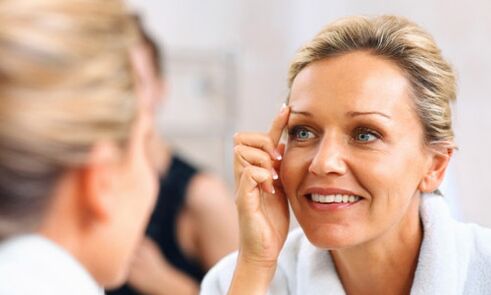
The first thing that comes to mind when talking about facelift is plastic surgery. However, not everyone is willing and able to expose themselves to radical influences. A compromise option in this case is many minimal and non-invasive rejuvenation techniques.
Non-surgical facelift– this is a whole range of various procedures that can improve the condition of the skin, eliminate sagging tissues and add clarity to the oval without surgical intervention and associated difficulties.
The main advantages of these techniques over surgery are relatively low cost, low trauma and fewer contraindications. At the same time, with their help, it is not always possible to achieve such an impressive result as after surgery, and it does not last so long, usually up to 2-3 years, which compensatespartly the cost/benefit ratio.
Basic methods of non-surgical lifting
All non-surgical facelift procedures can be divided into several large groups:
- Injectable– subcutaneous administration of drugs helping to improve the tone and overall rejuvenation of the skin. This includes certain types of mesotherapy, remodeling and plasma lifting.
- Material– are carried out on equipment using different types of energy (laser, radio waves, microcurrent, etc. ) to act on the skin.
- Lifting with wires– installation of special biocompatible threads under the skin, with the help of which the tissues are moved to a new position. Most types of thread lift are surgical techniques, but their invasiveness and number of contraindications are significantly lower than other anti-aging facial surgeries.
- Deep peels, during which the upper layers of the dermis are removed. Stimulate skin renewal and thus provide a lifting effect
- Manual practices– various massage techniques aimed at improving the tone of facial muscular structures and activating metabolism.
Injection lifting and facial rejuvenation
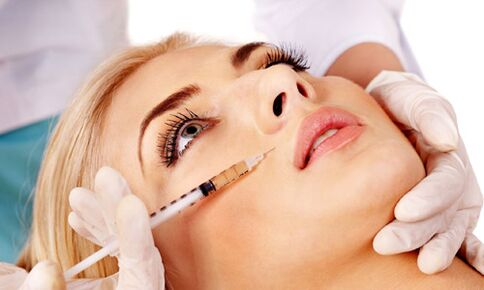
One of the safest and most common methods in this group ismesolifting– a variant of mesotherapy using a specially selected complex of moisturizing and strengthening active substances, which activates the process of cell renewal, fills them with moisture and improves local blood circulation. The standard course includes 3-5 procedures, the duration of the result is 6-18 months. After mesolifting, aging and sagging skin are visibly smoothed, appear fresh and young, deep static wrinkles are reduced and small expression lines disappear, the skin is renewed at the cellular level, its color is unified, its turgor andits elasticity improves.
PlasmoliftingOrPRP therapyis an injection of the patient's own blood (or rather, plasma that has undergone special pretreatment). The course is 4-5 sessions, the result lasts about 1 year. Plasmolifting acts both locally, at the cellular level of the skin, by triggering the synthesis of collagen fibers, and has a rejuvenating effect on the entire body - it stimulates the immune system, triggers regeneration and renewal processescellular. In addition, plasma, like a biological glue, attaches the facial skin to the underlying structures, eliminating age-related tissue ptosis. After completing the course, the skin smoothes, becomes more elastic, toned, fine wrinkles disappear and deep wrinkles decrease.
If meso- and plasmolifting have a complex effect on the entire face, firming and rejuvenating it, thencontour plastic surgery with fillersAndbotulinum therapydesigned to specifically address specific age-related issues.
- Filler injections aim to fill deep wrinkles, restore the volume of missing tissues and correct the shape of the face. Today, cosmetologists have a wide range of products, mainly based on high density hyaluronic acid, intended to correct certain age-related facial defects.
- Botulinum therapy uses medications based on botulinum toxin type A, which block the nerve endings in the injection area and prevent them from contracting the facial muscles. Thus, the skin is smoothed and even deep expression lines are reduced or disappear completely.
The effect of remodeling and botulinum therapy lasts about 8-12 months, depending on the activity of metabolic processes and other individual characteristics of the body.
Hardware tightening methods
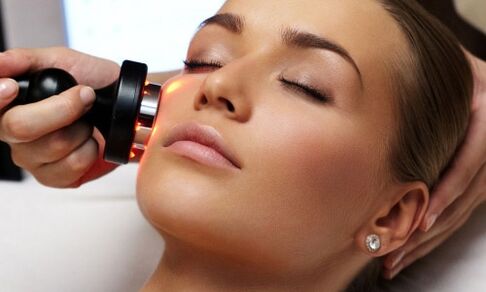
How Most Methods Worklifting equipmentthe same - the subcutaneous tissue is heated by targeted action, which stimulates the compaction of existing collagen fibers and the production of new collagen and elastin. Result: wrinkles are smoothed, pores tighten, the skin becomes firmer and elastic. The main differences between these procedures lie in the type of energy used (laser, radio waves, etc. ). Otherwise, they are very similar: they are carried out over 3 to 5 sessions and the duration of the results is approximately 2 years. Today, the most popular methods are:
- Laser thermolifting– laser energy is used;
- ELOS-lifting– based on the influence of two types of energy at once: laser and light;
- Radio Frequency (RF) Lifting– low power, high frequency radio waves are used.
Another option -microcurrent therapy, – works a little differently. In this case, skin cells are stimulated by microcurrents and specially developed biological preparations containing powerful antioxidants that activate natural skin regeneration mechanisms.
The standard course of such a non-surgical facelift includes 4-5 procedures performed once a week. The main advantages of this method include a minimal number of contraindications and complete safety for the body. Microcurrents activate metabolism, normalize the chemical composition of cells and increase tissue elasticity. It is for this reason that they are often used as a restorative procedure after surgical procedures.
Lifting with wires
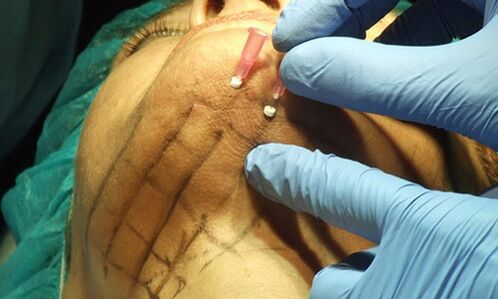
This is a minimally invasive technique in which fine threads are inserted under the skin. Then they are pulled up, moving behind them and fixing the soft tissues in the desired position. The procedure is quick and safe, but nevertheless quite serious, so it should not be carried out by a cosmetologist working with the "external part" of the face, but by a plastic surgeon who is well versed in its internal structure. Depending on the general indications and personal preferences of the patient, the following may be used:
- Non-absorbable threads, made from biocompatible materials such as polypropylene.
- Mesothreads- are considered a little less effective, but they consist of polylactic acid, which does not remain under the skin, but is completely absorbed after a few months. In addition to the firming itself, they have a beneficial effect on the general condition and health of the skin (similar to mesotherapy, hence the prefix "meso" in the name)
The obtained result lasts on average 2-3 years, after which you can install additional threads or choose a different technique (already installed threads will not interfere with either cosmetic procedures or surgical facelift). Some of the non-absorbable threads may be "tightened" in the future, but there is no consensus among experts on whether such manipulation is appropriate.
Deep peels
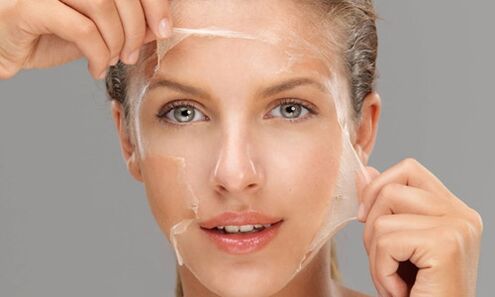
These are quite traumatic and painful, but at the same time very effective procedures, with the help of which you can improve the regeneration processes of the skin, improve its color, smoothness and elasticity, and also eliminate many external defects (hyperkeratosis, hyperpigmentation, etc. ).
- Duringdeep chemical peelAcid compositions based on phenol are applied to the face, which destroy the upper layers of the skin down to the middle of the reticular layer of the dermis. The procedure is carried out only in a clinical setting, under general anesthesia - as a full-fledged operation.
- Deep laser resurfacingcombines two processes: the application of thermal microtrauma to the skin, which triggers internal recovery mechanisms and the vaporization (evaporation) of old cells. Modern fractional ablative lasers perform both of these actions simultaneously, allowing you to achieve a more pronounced lifting effect in fewer sessions than with previous generations of lasers.
The recovery period after a deep peel is quite long (rehabilitation takes up to 2 weeks). The effect lasts approximately 1 year. If we compare the two procedures, laser resurfacing has an important advantage: the ability to adjust the power and depth of impact "on the fly". This makes it possible to select optimal parameters for each area, even the most sensitive (eyelids, lips, neck), which is impossible to obtain with a chemical peel. In addition, the cooling system makes it less painful, allowing the use of local anesthesia.
Massage as a non-surgical facelift method

With the help of manual influence, it is also possible to achieve a certain lifting effect, although experts' opinions regarding its severity and duration are very different. The most popular procedure in this group issculptural facial massage(plasticizing massage, facial massage according to Joelle Siocco and other exclusive techniques).
The principle of its action is based on deep strength training of facial and non-facial muscles with simultaneous activation of lymphatic drainage. The massage therapist "sculpts" the contours of the face, correcting problem areas. As a result, the oval becomes lighter, the manifestations of age-related changes are reduced, muscle tension is relieved, and the skin color improves.
The standard course consists of 10-12 sessions, carried out every 2-3 days. Additional maintenance procedures are required 2-3 times per month, which is a relative disadvantage of this non-surgical lifting method. The obvious advantages of sculptural massage are painlessness, complete safety, absence of rehabilitation period, absence of risk of complications, absence of skin irritation. The obvious downside is that the results are significantly less pronounced compared to the other procedures described above.
How to choose the best non-surgical facelift technique?
In order to smooth out and possibly completely eliminate the signs of aging, it is necessary to determine the causes of their appearance. This unique diagnosis is one of the main tasks of a cosmetologist or plastic surgeon. It is he who should be entrusted with the choice of a specific method of rejuvenation or their combination. In the case of a face, the question is generally:How localized are age-related changes?
- If they mainly affect the skin – e. g. We are talking about small wrinkles, changes in relief, a decrease in turgor - preference is given to methods that affect the dermal layer (restoration, compaction, strengthening the elastin-collagen framework, polishing existing defects). For this purpose, peels, thermolifting, plasma therapy and mesolifting are used.
- For problems with the subcutaneous structures of the face (deep wrinkles, pronounced tear furrows, jowls, bags under the eyes, loss of clarity of the oval of the face, double chin), favor methods that affect the muscular framework and thehypodermis. These include thread lift, botulinum therapy, contouring, microcurrent and sculptural massage.
- In many cases, the changes affect both the skin and internal structures, so to achieve a pronounced effect, a thoughtful combination of several rejuvenation techniques is necessary.
Expert opinion
Journalists asked leading cosmetologists to comment on the effectiveness of using certain non-surgical facelift options, and also turned to plastic surgeons for a professional opinion:
"The question is much simpler than it seems. In order not to be mistaken in the choice of technique, not to undergo surgery ahead of schedule, but also not to spend more time than expected in cosmetologists' offices, it is enough to understand three things:
- Condition of soft tissues, degree of ptosis.If the age-related changes have not gone too far, we can talk about non-surgical solutions. If we are talking about pronounced folds and quite a lot of excess skin, do not waste time and money on cosmetology, make no mistake. Excess skin will not disappear on its own, it can only be removed with a scalpel, and only a plastic surgeon will help you here.
- Age. Up to the age of 40 (most often), cosmetic procedures work quite well. After 40 years, their effect becomes less and less noticeable, and after 50, if you need a real effect, and not just care, you should seriously think about surgery.
- The patient's wishes.Only you determine who to contact and what you need. Not all women want to look 10-20 years younger; For many, it is important simply to look well-groomed and fresh enough for their age. This problem can be resolved without surgery. Dull skin, sagging, fine wrinkles, age spots, etc. – cosmetologists cope well with all these problems. But if you are not satisfied with sagging facial contours, drooping eyelids, jowls, bags under the eyes, double chin or neck folds, only contact a surgeon.
If you need a very small facelift, pay attention to vector facelift with various threads or contour plastic surgery. By repeating these procedures 1-2 times a year, you can postpone the operation for several years. You yourself will understand when the effect obtained no longer suits you and it will be time to think about more radical methods.
"Of course, non-surgical methods will not replace plastic surgery, but they are a good means of prevention and can delay the visit to the surgeon for a long time. Women may be advised to have gentle facelifts (hardware cosmetology) from the age of 25. Almost each of the methods listed in the article can help manage some subtle age-related changes. Our specialists use some of these procedures individually, but most often as part of a comprehensive program.
So, after a surgical facelift, stagnation may occur, which can be easily treated using microcurrents. Contour plastic surgery with fillers makes it possible to correct minor age-related changes, but in this case plasma fillers (analogs of hyaluronic acid fillers, produced from own bloodof the patient) have proven themselves.
Botulinum toxin A preparations, of course, give good results and it is impossible to replace them with analogues. RF facelift also gives a good effect both for the prevention of aging and during maintenance treatment after plastic surgery. But phenol peeling is not used in our clinic due to its traumatic nature.
An important advantage of non-surgical facelift procedures is that they can be recommended to fairly young patients, with subtle age-related changes. For example, a gentle alternative to blepharoplasty can be plasma, laser or RF lifting, as well as mesothreads - the exact choice will depend on the "severity" of the skin, depth of wrinkles, ageof the patient and the presence of certain contraindications.
"I would like to immediately emphasize that, of course, none of the minimally invasive techniques can compete in effectiveness with surgical operations. However, it often happens that the patient's state of health does not allow him to take such a measure or the particular situation does not yet require surgical intervention. In these cases, minimally invasive cosmetology comes to our aid.
Thread facelift, laser facelift and RF facelift techniques may well delay the need for surgery and serve as a sort of temporary replacement for surgical facelift techniques. Botulinum therapy and fillers can eliminate wrinkles. Plasmolifting improves skin turgor and its general condition. Peels are also responsible for the turgor, color and quality of the skin. These procedures are effective in their field of action, but do not constitute a direct alternative to plastic surgery.
The clinic performs almost all of the procedures described in the article, however, each of them has both indications and contraindications. In particular, for patients who come to us for a total facelift, I recommend plasma facelift before and after surgery, this helps shorten the rehabilitation period. But it is not worth carrying out hardware rejuvenation procedures before surgery.
"Currently, there are a large number of effective methods of non-surgical facial rejuvenation, but it is important to understand the difference between the capabilities of a plastic surgeon and a cosmetologist. The surgeon creates the contour of the face, the beautician improves the quality of the skin. And aging is manifested by sagging skin and muscles, a reduction in complexion and a deterioration in its quality. In total, there are about 5 types of aging, depending on their manifestations, and a rejuvenation program is developed, using in particular non-surgical techniques.
Today I consider hardware procedures (laser fractional photothermolysis, laser thermolifting), RF facelift, as well as contour plastic surgery and thread lifting to be the most effective. But it should honestly be noted that in case of severe ptosis and a large amount of subcutaneous fat, all types of hardware lifting are ineffective, since they affect the deep layers of the skin without affecting its surface. In addition, the so-called 3D facial modeling is very popular and effective, which uses a set of measures: contouring, thread lifting, botulinum therapy.
In general, we have a fairly large selection of minimally invasive facelift methods in our arsenal, but to achieve the best results, an integrated approach is always necessary. A single method, no matter how effective, cannot solve all problems.
























